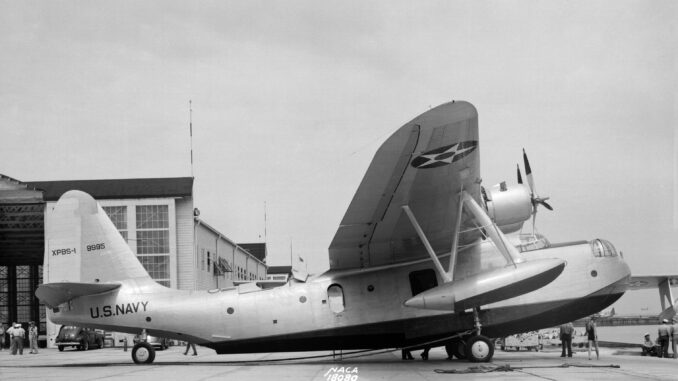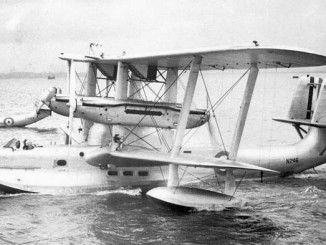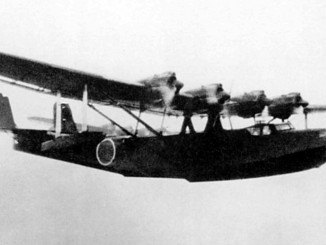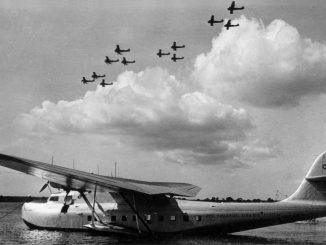
As the US Navy was beginning to receive the first prototypes of the aircraft that would become the PBY Catalina, it simultaneously began to solicit proposals for the eventual replacement of this flying boat. The Navy was beginning to show interest in larger, more powerful, multi-engine aircraft which appeared to offer superior performance, flying at speeds of 200mph and ranges of close to 3,500 miles. With these goals in mind Consolidated and Sikorsky, both imminent flying boat manufacturers, were asked to provide proposals. The Consolidated design would go on to become the successful PB2Y Coronado, whilst Sikorsky would produce just a single model of their XPBS.
In common with the most common flying boat designs of the time, the XPBS featured a high mounted wing which was fitted with four Pratt & Whitney R-1830 engines. It also had a single tail and fixed floats outboard of the engines. Igor Sikorsky had pioneered a design for a tail turret and naturally the thoroughly modern XPBS would include this feature, with three other weapons positions. Initially the aircraft was designed to carry a load of 4,000lb of ordnance, but this was later increased to 12,000lb with the final engine specification. It also featured innovative electrical and communication systems. Evaluation flights revealed that the XPBS-1 met or exceeded the Navy’s requirements, but nevertheless the production contract was awarded to Consolidated and the PB2Y would enter full production in time to see significant war service.
Although the design was not accepted for large scale production, the single prototype XPBS-1 was retained by the Navy and used as a transport aircraft. It flew neutrality patrols along the eastern seaboard before Pearl Harbor, and then spent the early war months ferrying spare parts for Patrol Wing 10 to Australia. It was then assigned to the newly commissioned Naval Air Transport Squadron (NATS) unit VR-2 in April 1942, where the flying boat was to be used mainly for mail and passenger flights between Hawaii and San Francisco.
Perhaps the most famous incident involving the XPBS-1 occurred just a few weeks after the Battle of Midway, when American forces had just begun to turn back the tide of the Japanese offensive. Commander-in-Chief of the Pacific Fleet, Admiral Chester W. Nimitz, was flying back to the United States for a command conference aboard the XPBS-1. As the aircraft came in to land at Naval Air Station Alameda on June 30th 1942, it struck a log floating in the water. The aircraft flipped upside down with every occupant suffering injuries, and the co-pilot Lt Thomas M. Roscoe was killed in the crash. The XPBS-1 itself sank and was a total loss. Nimitz suffered relatively minor injuries and personally directed some of the rescue efforts. One wonders how the course of the war would have been altered had the admiral suffered a more serious fate.
Undeterred by the loss to the PB2Y, Sikorsky persisted with the design and produced three civilian VS-44 versions for American Export Airlines. Named Exeter, Excalibur, and Excambion, they were due to be assigned to the New York-Lisbon transatlantic route but the United States entered the war before the service could commence. All three aircraft were requisitioned by the Navy and were given the designation JR2S-1. Excalibur was destroyed in a crash upon take-off at Botwood, Newfoundland on October 3rd 1942. 11 of the 37 passengers were killed, with four more missing and never recovered, and the aircraft was lost. The remaining pair flew several hundred transatlantic crossings during the war, ferrying thousands of passengers including a number of notable VIPs.
Sikorsky XPBS Specifications
| Sikorsky JR2S-1 VS-44A | |
| Role | |
| Crew | 5 |
| Powerplant | 4x Pratt & Whitney R-1830-S1C3-G (1,050hp) |
| Speed | 175mph (cruise) 210mph (max) |
| Ceiling | 18,996ft |
| Range | 3,598 miles (internal) |
| Armament | |
| Ordnance | |
| Dimensions | 79ft 3in (length) 124ft 0in (wingspan) 0ft 0in (height) |
| Wing Area | 1670 sq.ft. |
| Weight | |
| Number produced | 3 |





Leave a Reply